Serbian dinar facts for kids
Quick facts for kids Serbian dinar |
|||||
|---|---|---|---|---|---|
|
|||||
| ISO 4217 Code | RSD | ||||
| User(s) | |||||
| Inflation | 8.0% (2023) | ||||
| Source | NBS | ||||
| Subunit | |||||
| 1⁄100 | пара / para (defunct) | ||||
| Symbol | DIN / дин | ||||
| Plural | динари / dinari ("dinars")The language(s) of this currency belong(s) to the Slavic languages. There is more than one way to construct plural forms. See article. | ||||
| Coins | |||||
| Freq. used | din. 1, din. 2, din. 5 | ||||
| Rarely used | din. 10, din. 20 | ||||
| Banknotes | |||||
| Freq. used | din. 10, din. 20, din. 50, din. 100, din. 200, din. 500, din. 1,000, din. 2,000 | ||||
| Rarely used | din. 5,000 | ||||
| Printer | Institute for Manufacturing Banknotes and Coins - Topčider | ||||
The dinar is the official money used in Serbia. The word "dinar" comes from the ancient Roman coin called "denarius." People in Serbia first used the dinar way back in 1214. It was brought back as Serbia's official money by Prince Mihailo in 1868. Before, one dinar was split into 100 "para," but this smaller unit is not used anymore. As of August 2024, about 104.57 dinars are worth 1 US dollar.
Contents
History of the Dinar
Medieval Serbian Dinar
The first time we hear about a "Serbian dinar" was in 1214, during the rule of Stefan Nemanjić. Many Serbian rulers, until 1459, made silver dinar coins.
These early Serbian dinars looked a lot like coins from other parts of southern Europe, especially the "Venetian grosso." They even had Latin words on them. Serbian dinars were important for trade because Serbia had a lot of silver from its mines. Some people, like the famous writer Dante Alighieri, were not happy about how similar Serbian coins were to Venetian ones.
First Modern Serbian Dinar (1868–1920)
After the Ottoman Empire took over, many different foreign coins were used in Serbia until the mid-1800s. The Ottomans even had places where they made coins in Serbia. The smaller unit of the dinar, called the para, got its name from Turkish silver coins.
When the Principality of Serbia was officially formed in 1817, there were still many different foreign coins. Prince Miloš Obrenović decided to make things simpler. He set up exchange rates for 43 different foreign coins.
In 1867, the last Ottoman soldiers left Serbia. This meant Serbia needed its own money. So, Prince Mihailo Obrenović ordered that a national currency be made.
The first bronze coins came out in 1868. Silver coins followed in 1875, and gold coins in 1879. The first paper money was printed in 1876. From 1873 to 1894, the dinar's value was linked to the French franc. Serbia also joined a group of countries called the Latin Monetary Union. This meant their money was based on both gold and silver until 1914.
In 1920, the Serbian dinar was replaced by the Yugoslav dinar.
Coins of the First Modern Dinar

In 1868, bronze coins were made in values of 1, 5, and 10 paras. They had a picture of Prince Mihailo Obrenović III. Silver coins came out in 1875 (50 paras, 1 and 2 dinars), and then 5 dinars in 1879. The first gold coins were made in 1879 for 20 dinars, and 10 dinars in 1882. Gold coins made for King Milan I's coronation in 1882 were often called milandor, which means "Milan of Gold" in French. In 1883, new coins made of copper and nickel were introduced for 5, 10, and 20 paras. Bronze 2 para coins came out in 1904.
Banknotes of the First Modern Dinar
In 1876, the government started issuing paper money in values of 1, 5, 10, 50, and 100 dinars. The National Bank then issued its own notes starting in 1884. These included 10 dinars backed by silver, and 50 and 100 dinars backed by gold. Later, 20 dinar gold notes and 100 dinar silver notes were introduced in 1905. However, people didn't trust the gold-backed notes much. They preferred to trade goods or exchange the notes for gold coins right away. Silver-backed notes, however, were popular and made up most of the paper money in use. During the Balkan Wars and World War I, you couldn't exchange banknotes for gold and silver for a while. During World War I, silver notes for 50 and 5 dinars were introduced. In 1915, even postage stamps were allowed to be used as money for small amounts.
Second Modern Serbian Dinar (1941–1944)
In 1941, during the German occupation of Serbia, a second Serbian dinar was introduced. It replaced the Yugoslav dinar. This new dinar was linked to the German reichsmark: 250 dinars were worth 1 reichsmark. This money was used until 1944. Then, the Yugoslav dinar was brought back, with 1 Yugoslav dinar being worth 20 Serbian dinars.
Coins of the Second Modern Dinar
In 1942, coins made of zinc were introduced in values of 50 paras, 1, and 2 dinars. Ten dinar coins followed in 1943.
Banknotes of the Second Modern Dinar
In May 1941, the Serbian National Bank started issuing paper money for 10, 20, 50, 100, 500, and 1,000 dinars. Some of these notes were simply older Yugoslav notes with new printing on them. More notes were issued in 1942 and 1943.
Third Modern Serbian Dinar (2003–Present)
The Serbian dinar we use today replaced the Yugoslav dinar in 2003. This happened when the country of Serbia and Montenegro was formed. Before this, Montenegro and the area of Kosovo had already started using the German Deutsche Mark, and later the euro when it replaced the Mark in 2002.
However, Serbs living in North Kosovo and other Serbian areas there still use the dinar. In February 2024, the Kosovan government said that the euro would be the only legal money for payments. The Prime Minister of Kosovo, Albin Kurti, later explained that the dinar wasn't completely banned, but the euro would be the main money for business. He also said there would be a few months to get used to the new rule.
Between 2003 and 2006, the Serbian dinar had the code CSD. This code came from "CS," which was the country code for Serbia and Montenegro. When Serbia and Montenegro separated in 2006, the dinar's code changed to the current RSD.
Coins of the Third Modern Dinar
The coins you can use today are 1, 2, 5, 10, and 20 dinars. All these coins have the same words written on them in both the Cyrillic and Latin alphabets, which are used in Serbia. The 10 and 20 dinar coins are not seen as often because people usually use paper money for those values instead.
| Coins | |||||||||||||||
|---|---|---|---|---|---|---|---|---|---|---|---|---|---|---|---|
| Image | Value | Technical parameters | Description | Date of | |||||||||||
| Diameter | Mass | Composition | Edge | Obverse | Reverse | minting | issue | withdrawal | lapse | ||||||
| din. 1 | 20 mm | 4.34g | 70% Cu, 12% Ni, 18% Zn | reeded | Denomination, relief of the building of the National Bank of Serbia, year of minting | Issuer's symbols, logo of the National Bank of Serbia | 2003,2004 | 2 July 2003 | Current | ||||||
| din. 1 | 20 mm | 4.26g | 75% Cu, 0,5% Ni, 24,5% Zn | reeded | Coat of arms of Serbia, issuer's symbols | 2005-2009 | 2 July 2005 | ||||||||
| din. 1* | 4.2g | Multilayer; low carbon steel core coated with a layer of copper on both sides/electroplated with a layer of copper and a layer of brass | 2009~present | 20 March 2009 | |||||||||||
| din. 2 | 22 mm | 5.24g | 70% Cu, 12% Ni, 18% Zn | reeded | Gračanica monastery | Issuer's symbols, logo of the National Bank of Serbia | 2003 | 2 July 2003 | |||||||
| din. 2 | 22 mm | 5.15g | 75% Cu, 0,5% Ni, 24,5% Zn | reeded | Coat of arms of Serbia, issuer's symbols | 2006~2010 | 27 December 2006 | ||||||||
| din. 2* | 5.05g | Multilayer; low carbon steel core coated with a layer of copper on both sides/electroplated with a layer of copper and a layer of brass | 2009~present | 20 March 2009 | |||||||||||
| din. 5 | 24 mm | 6.23g | 70% Cu, 12% Ni, 18% Zn | reeded | Krušedol monastery | Issuer's symbols, logo of the National Bank of Serbia | 2003 | 2 July 2003 | |||||||
| din. 5 | 24 mm | 6.13g | 75% Cu, 0,5% Ni, 24,5% Zn | reeded | Coat of arms of Serbia, issuer's symbols | 2005~2012 | 2 July 2005 | ||||||||
|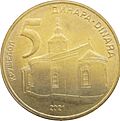 |
din. 5* | 5.78g | Multilayer; low carbon steel core coated with a layer of copper on both sides/electroplated with a layer of copper and a layer of brass | 2013~present | 5 July 2013 | ||||||||||
| din. 10 | 26 mm | 7.77 g | 70% Cu, 12% Ni, 18% Zn | reeded | Studenica monastery | Logo of the National Bank of Serbia | 2003 | 2 July 2003 | current | ||||||
| din. 10 | Serbian coat of arms | 2005~present | 2 July 2005 | ||||||||||||
| | | din. 10 | 26 mm | 7.77 g | reeded | 2009 Summer Universiade logo | Serbian coat of arms | 2009 | 26 June 2009 | |||||||
| 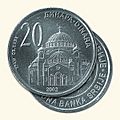 |
din. 20 | 28 mm | 9.00 g | reeded | Church of Saint Sava | Logo of the National Bank of Serbia | 2003 | 2 July 2003 | |||||||
|  |
din. 20 | 28 mm | 9.00 g | reeded | Portrait of Nikola Tesla | Serbian coat of arms | 2006 | 30 July 2006 | |||||||
| 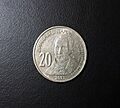 |
din. 20 | 28 mm | 9.00 g | reeded | Portrait of Dositej Obradović, Serbian writer and philosopher | Serbian coat of arms | 2007 | 10 December 2007 | |||||||
| | | din. 20 | 28 mm | 9.00 g | reeded | Portrait of Milutin Milanković | Serbian coat of arms | 2009 | 26 June 2009 | |||||||
| | | din. 20 | 28 mm | 9.00 g | reeded | Portrait of Đorđe Vajfert, industrialist and former Governor of the National Bank of Serbia | Serbian coat of arms | 2010 | 16 June 2010 | |||||||
| |
din. 20 | 28 mm | 9.00 g | reeded | Portrait of Ivo Andrić, Serbian Nobel Prize winner | Serbian coat of arms | 2011 | 20 May 2011 | |||||||
| | | din. 20 | 28 mm | 9.00 g | reeded | Portrait of Mihajlo Pupin, Serbian physicist and philanthropist | Serbian coat of arms | 2012 | 8 June 2012 | |||||||
These images are to scale at 2.5 pixels per millimetre. For table standards, see the coin specification table.
|
|||||||||||||||
Banknotes of the Third Modern Dinar
In 2003, the National Bank of Serbia started issuing new paper money. The first values were 100, 1,000, and 5,000 dinars. A 500 dinar note came out in 2004, followed by 50 dinars in 2005. In 2006, 10, 20, and 200 dinar notes were introduced. Finally, a 2,000 dinar note was added in 2011.
| Denomination | Obverse image | Reverse image | Main colour | Obverse | Reverse | Remark |
|---|---|---|---|---|---|---|
| din. 10 131 × 62 mm |
 |
 |
Ochre-yellow | Vuk Stefanović Karadžić (1787 – 1864), philologist and linguist | Member of the First Prague Slavic Congress, 1848 and a vignette of the letters Vuk introduced. | Replaced with a slightly lighter 2006 issue. A revised issue entered circulation in 2011. |
| din. 20 135 × 64 mm |
 |
 |
Green | Petar II Petrović-Njegoš (1813 – 1851), metropolitan, statesman, philosopher, and poet | His figure on the back, instead of the statue from the Mausoleum on Mount Lovćen. | Replaced with a slightly darker 2006 issue. A revised issue entered circulation in 2011. |
| din. 50 139 × 66 mm |
 |
 |
Violet | Stevan Stojanović Mokranjac (1856 – 1914), composer and music educator | Figure of Stevan Stojanović Mokranjac, a motif of Miroslav Gospels illumination scores. | Redesigned in 2005. A revised issue entered circulation in 2011. |
| din. 100 143 × 68 mm |
 |
 |
Blue | Nikola Tesla (1856 – 1943), inventor | A detail from the Tesla electro-magnetic induction engine. | Redesigned in 2003, 2004 and 2006. A revised issue entered circulation in 2012. |
| din. 200 147 × 70 mm |
 |
 |
Brown | Nadežda Petrović (1873 – 1915), painter | Silhouette of the Gračanica Monastery. | Redesigned in 2005. A revised issue entered circulation in 2011. |
| din. 500 147 × 70 mm |
 |
 |
Cyan | Jovan Cvijić (1865 – 1927), geographer | Stylized ethnic motifs. | Redesigned in 2007. A revised issue entered circulation in 2011. |
| din. 1,000 151 × 72 mm |
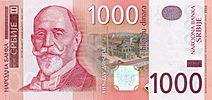 |
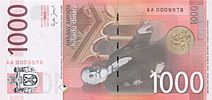 |
Red | Đorđe Vajfert (1850 – 1937), industrialist | An outline of Weifert's beer brewery, hologram image of St. George slaying a dragon; details from the interior of the main building of the National Bank of Serbia. | Redesigned in 2003 and 2006. A revised issue entered circulation in 2011. |
| din. 2,000 155 × 74 mm |
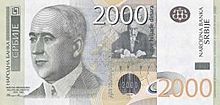 |
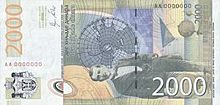 |
Grey | Milutin Milanković (1879 – 1958), mathematician, astronomer and geophysicist | Milanković's figures while at the desk (below: a graphical representation of his calculations of snow boundary movement for the past Quaternary) and from his student days in Vienna (behind: a stylised Sun disk drawing fragment and an illustration of Milanković's work). | Entered circulation in 2011. |
| din. 5,000 159 × 76 mm |
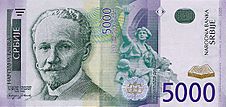 |
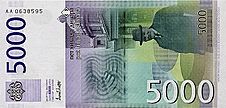 |
Purple | Slobodan Jovanović (1869 – 1958), jurist, historian and politician | Stylized representation of the interior of the assembly hall; silhouette of the National Assembly. | Redesigned in 2010. A revised issue entered circulation in 2016. |
See also
 In Spanish: Dinar serbio para niños
In Spanish: Dinar serbio para niños
- Economy of Serbia
- Macedonian denar
- Yugoslav dinar
- Yugoslav krone



